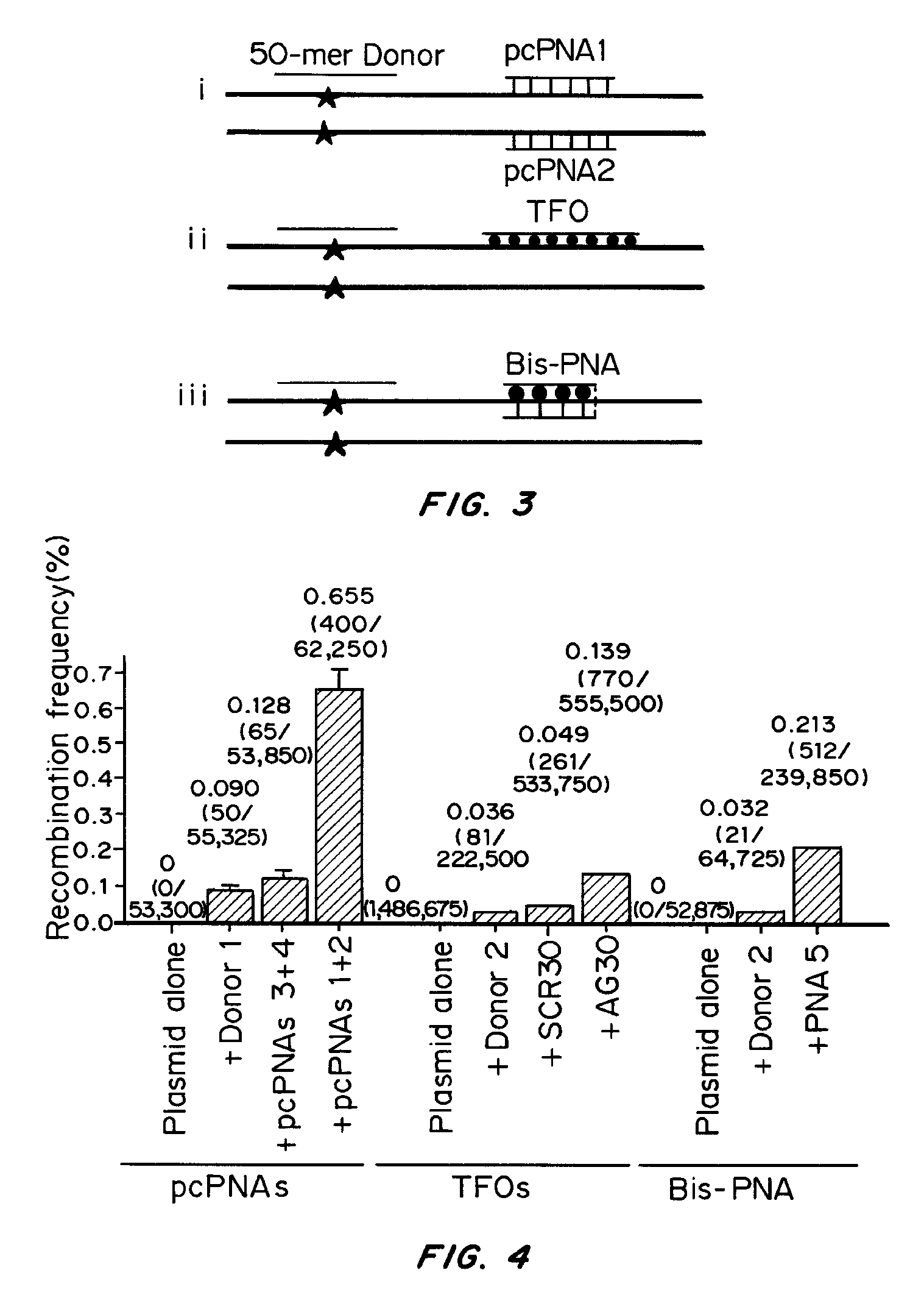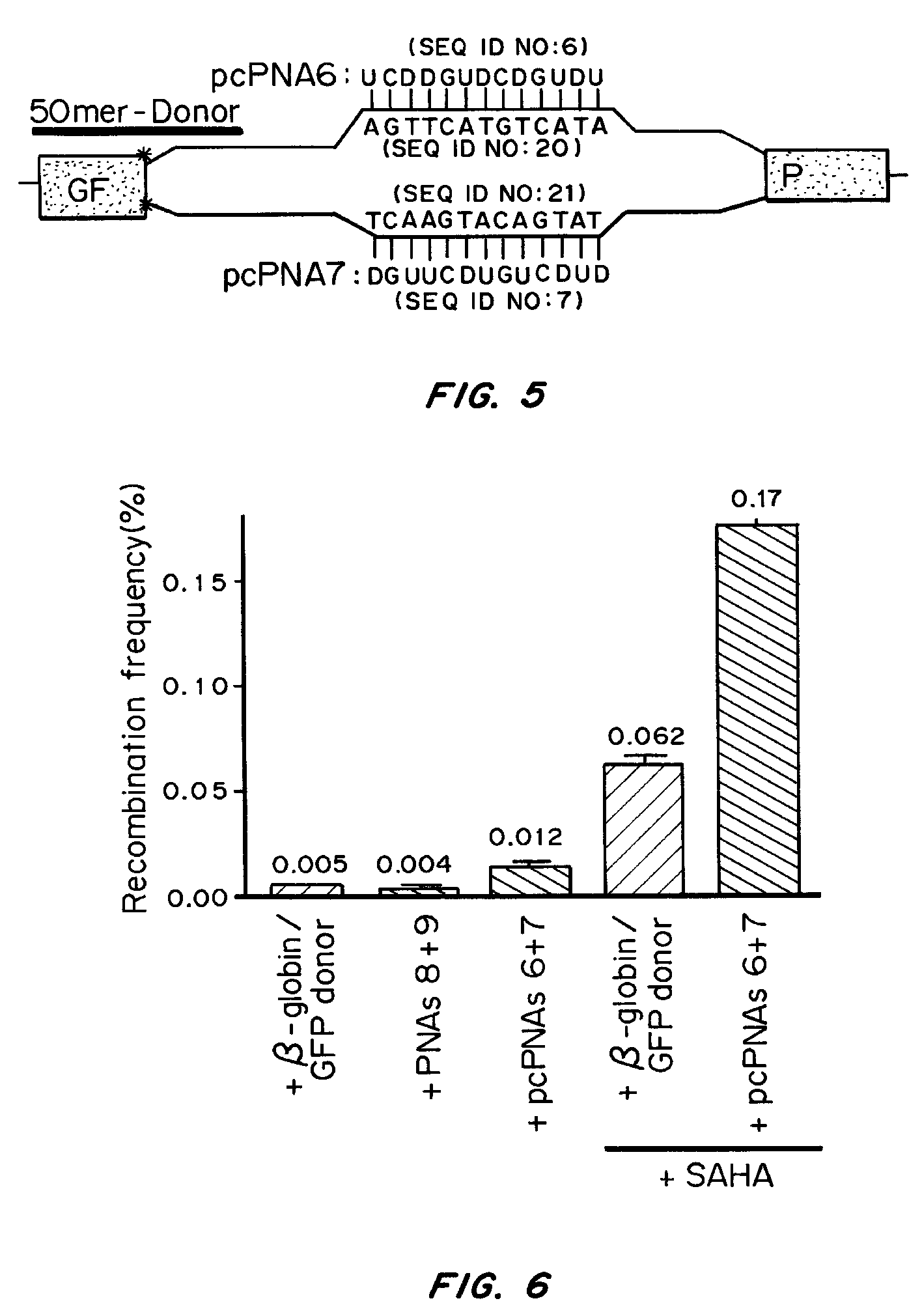Pseudocomplementary oligonucleotides for targeted gene therapy
a technology of complementary oligonucleotides and targeted gene therapy, which is applied in the field of pseudocomplementary oligonucleotides, can solve the problems of not being able to mediate targeted genome modification in cells, not preventing pcpnas, and both approaches are limited, so as to achieve the effect of higher percentage of recombination
- Summary
- Abstract
- Description
- Claims
- Application Information
AI Technical Summary
Benefits of technology
Problems solved by technology
Method used
Image
Examples
example 1
Initial Test on a Plasmid Target
[0083]pcPNA Design and Binding Motif
[0084]The base pairs that are the basis of the pcPNA strategy, D:T and A:sU, are shown in FIG. 1a, along with the canonical A:T base pair. There is potential steric interference between the thio and amino groups of sU and D, respectively, in the apposition of sU and D, that prevents pairing between these analogs. Since sU and D can bind without steric hindrance to A and T, respectively, pcPNA pairs can bind cognate DNA but not each other. This property underlies the ability of pcPNAs to form double duplex strand invasion complexes on duplex DNA, as shown in FIG. 1.
[0085]Materials and Methods
[0086]pcPNAs and Oligonucleotides
[0087]Boc-protected PNA monomers of 2-thiouracil and 2,6-diaminopurine were synthesized according to Lohse, et al., Proc. Natl. Acad. Sci. USA, 96:11804-11808 (1999). These monomers were used together with commercially available Boc-protected G and C PNA monomers (Applied Biosystems, CA). PNA olig...
example 2
Targeted Correction of a Thalassemia Associated Mutation in a Chromosomal Locus
[0097]Materials and Methods
[0098]Cells
[0099]The β-globin intron IVS2-1 (G→A) carrying a thalassemia-associated mutation or its wild-type equivalent IVS2 wt was inserted into the eGFP cDNA sequence of the pEGFP-N1 plasmid (Clontech, Palo Alto Calif.), between nucleotides 105 and 106, by PCR-based homologous recombination, resulting in pGFP / IVS2-1 and pGFP / IVS2 wt, respectively. The HinDIII-NotI fragments of these plasmids, containing the GFP sequence interrupted by IVS2-1 or IVS2 wt construct, were subcloned into the multiple cloning site of pcDNA5 / FRT (Invitrogen, Carlsbad, Calif.), and the resulting vectors were stably transfected into CHO-Flp host cell lines using the Flp-In System according to manufacturer's instructions (Invitrogen, Carlsbad Calif.). Clones that had undergone single-copy integration at the expected site were isolated by selection and confirmed via Southern blot (data not shown). The r...
example 3
Increased pcPNA-Mediated Gene Correction in Cells Synchronized in S-Phase
[0120]Materials and Methods
Cell Synchronization
[0121]Double thymidine addition was used for S phase synchronization. Thymidine was added to 1×106 cells in Ham's F12 media to a final concentration of 2 mM. Following a 12 h incubation period the thymidine-containing medium was replaced with normal culture medium, and the cells were grown for an additional 12 h to allow exit from S phase. The cells were grown again in medium containing 2 mM thymidine for another 12 h to synchronize the cells at the G1 / S border. The arrest was subsequently released by growing the cells in thymidine-free medium for 4-5 h to allow progression into S phase. Cell cycle profiles were determined by FACS, as above.
[0122]Results
[0123]Since manipulation of chromatin by the use of the HDAC inhibitor, SAHA, yielded an increased frequency of pcPNA-stimulated gene correction, selectively targeting cells in S-phase was also tested for improved g...
PUM
| Property | Measurement | Unit |
|---|---|---|
| concentration | aaaaa | aaaaa |
| length | aaaaa | aaaaa |
| distance | aaaaa | aaaaa |
Abstract
Description
Claims
Application Information
 Login to View More
Login to View More - R&D
- Intellectual Property
- Life Sciences
- Materials
- Tech Scout
- Unparalleled Data Quality
- Higher Quality Content
- 60% Fewer Hallucinations
Browse by: Latest US Patents, China's latest patents, Technical Efficacy Thesaurus, Application Domain, Technology Topic, Popular Technical Reports.
© 2025 PatSnap. All rights reserved.Legal|Privacy policy|Modern Slavery Act Transparency Statement|Sitemap|About US| Contact US: help@patsnap.com



